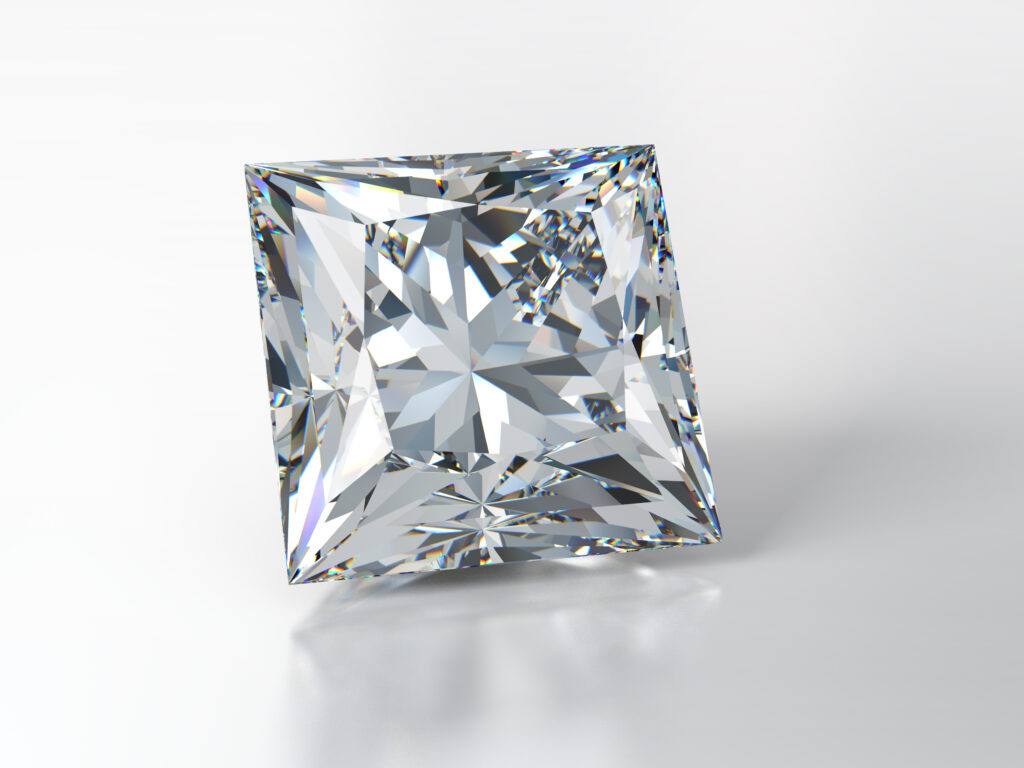
The three fundamental diamond cutting styles are brilliant cut, step cut, and mixed cut. The majority diamond manufacturers opt for the brilliant cut, characterised by triangular and kite-shaped facets that extend from a gem’s centre to its girdle. A modified brilliant is a brilliant cut with extra facets arranged symmetrically. A step cut is made up of long, narrow, four-sided facets set in rows parallel to the girdle on both the crown and pavilion. Mixed cuts feature brilliant-cut crowns and step-cut pavilions, or brilliant-cut pavilions and step-cut crowns. Any of these cutting styles can be utilised with a wide range of forms.
Brilliant cut includes shapes such as: round, pear, oval, marquise, triangular, heart, cushion, princess, and radiant.
Step cuts are: emerald, baguette, lozenge, trapeze, asscher.
Mixed cut is the combination of brilliant cut and step cut, it is a modified version of one of them.
Round Brilliant
The round brilliant is a classic shape that has been a choice for an engagement ring for many years. The reason for it is its wonderful light performance, the arrangement of the facets allows to play with the light and hide the inclusions. In jewellery the round brilliant is a great accent stone as it portrays the adamantine look of the diamond to the most.

Triangular Brilliant
Triangular brilliant, also called trillion, is another option of a shape when someone wants a great light performance but something different than a classic round brilliant. Trillions are often used as side stone, but they are also great as an accent stone as it gives a more contemporary look.

Oval
Oval cut gives a touch of elegance and classy look to the jewellery. It is more contemporary than the traditional round brilliant. One of the advantages of the oval diamond is the fact that it can look bigger face-up than round brilliant, even if they both are of the same weight. However, they quite often have the dark shadow in the middle of the table running across the width called a “bow-tie”. It mostly happens to diamonds that are cut to be very shallow or deep which causes the leakage of light and affects the overall appearance of the stone as well as its value. Today ovals are becoming more and more popular for an engagement ring; they are classy but a bit different than what people are used to seeing on a ring.

Pear
Pear shape is one of the brilliant cuts that is not very trendy for the rings yet, but are often used for drop earrings. Many people choose pear cut for the pendant necklace as well, however they tend to turn around on the chest, whereas round brilliant mostly stands still without moving. The pear cut looks more graceful for large diamonds, while large round brilliant looks a bit bulky. The tip of the pear can hide the inclusions well (applies to hearts, ovals, and marquises too), which could be a good selling point for a lower clarity stone. However, one should keep in mind that bow-tie effect is also present in the pear shape diamond.

Marquise
Marquise is an elongated version of an oval. It complements long finger as it makes the long finger look even longer and skinnier, but does not have this effect on the short finger. Marquise also can look bigger than the round brilliant of the same carat. It is a great choice for the unique jewellery designs. The two tips of the marquise can hide the inclusions (same as in pear cut), but bow-tie effect is an issue quite often.

Heart
Heart shape is a classic brilliant cut that has a symbol of romance and eternal love for many people. Many people choose it for solitaire pendants as it has an eye-catching look. Heart diamond is a great present for those who wish their gift to have a romantic sentiment. As with some other brilliant cuts, heart cut also may display bow-tie, but hide inclusions on the tip.

Princess
For people who want the look and the adamantine shine of the brilliant cut, but a square or rectangular shape, princess cut is an excellent option. It is also called radiant and quadrillion. These days one of the trends is a three-stone ring where princess cut diamonds of different carats are used. They are particularly a great choice for men’s jewellery, invisible setting or channel settings.

Radiant
Radiant is a great option for customers who want the square or rectangular shape of an emerald cut, but want it more flashy. The facets of radiant are arranged in such a way to give this sparkly effect, thus it is a scintillating alternative to an emerald cut. Moreover, it retains about 60% of the rough diamond whereas round brilliant only about 50%. Radiant is also a chosen cut when it is needed to move a gem into a fancy colour category – make colour more saturated.

Emerald
Emerald is a step-cut stone. It has a very classy look and can be in a shape of square of rectangular. It is important to keep in mind that the inclusions are visible more than in other cuts as there are less facets to cover them up. Therefore, it is worth choosing a high clarity stone, especially for the ring.

Asscher
It is quite a challenge to find a good quality of asscher cut diamond because only 2% of the rough diamonds are cut into it. However, owning a jewellery piece with asscher cut means that its owner has an exclusive stone. It is a step cut, therefore it is not as sparkly as the brilliant, but it still possesses the undeniable beauty and uniqueness. Asscher shows the colour of the diamond more than other cuts, therefore when grading it, the professionals may all see its colour more or less saturated. It looks great in a solitaire setting as its distinctive cut catches the eye of many people.





